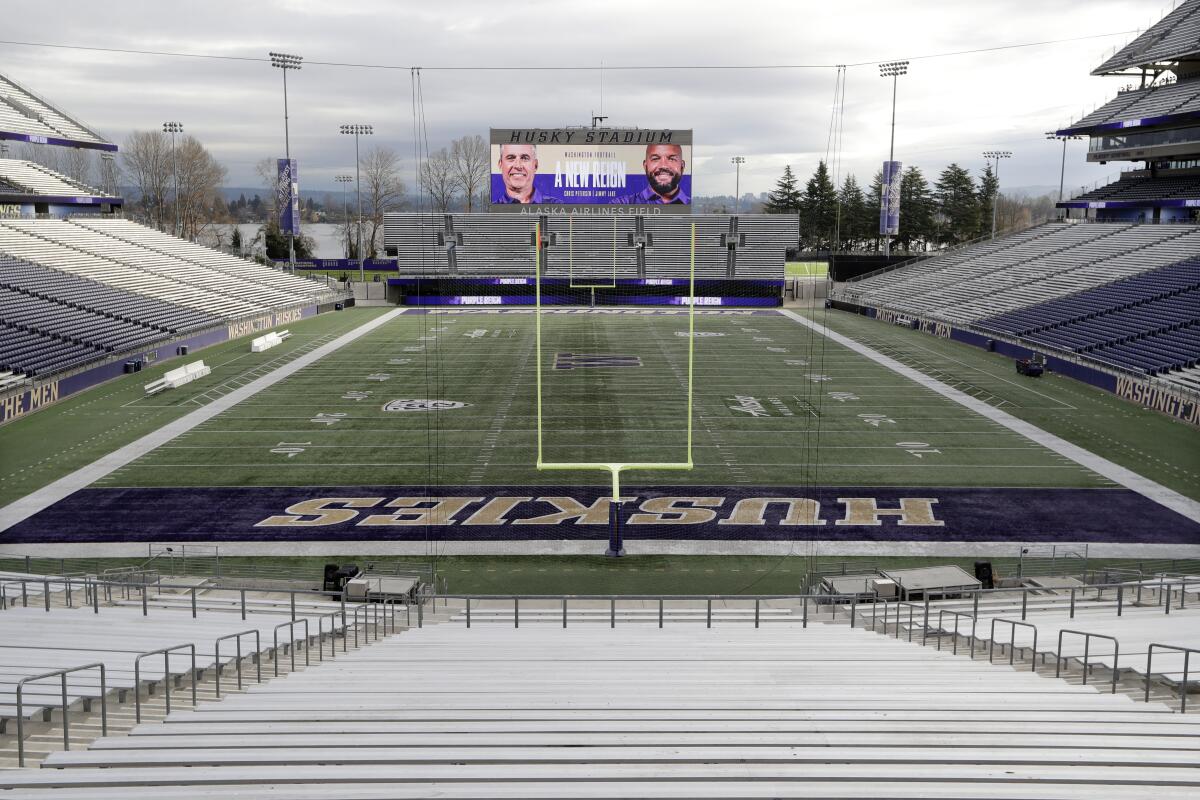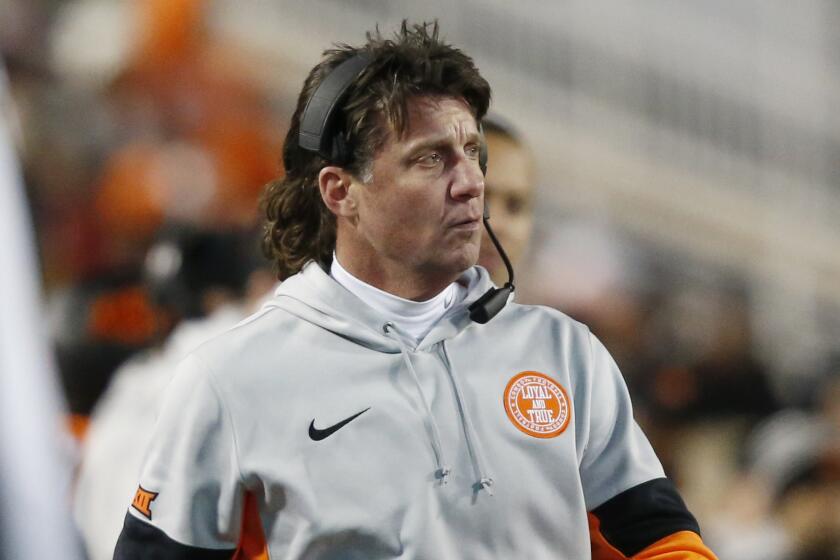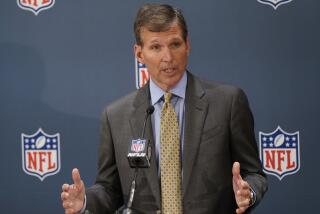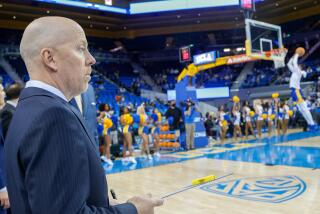Pac-12 football teams return to campus under rigid rules as USC, UCLA can only watch

- Share via
Used to be, college football players would disperse for the summer and return to campus in late July or early August, just in time for fall camp. They’d bombard the team doctor, getting the mandatory physicals out of the way while reconnecting with teammates and coaches they hadn’t seen in many weeks.
During the last decade, though, programs have all but hemmed their players within the school’s zip code because of intense offseason workout regimes, a philosophical shift that made Monday feel oddly nostalgic for Rob Scheidegger, Washington football’s trainer since 2002.
Here were the Husky seniors, players he’s been around with few breaks for three years, all returning to Seattle from various outposts and not having seen each other for three months.
“This is actually like old times a little bit,” Scheidegger said, knowing full well the irony of that sentiment in the midst of so much new.
Truth was, there had never been a day quite like this one in the history of Washington football.
Oklahoma State players, including Heisman candidate Chuba Hubbard, are the latest to call for social change after coach Mike Gundy wore a right-wing news outlet T-shirt.
Entering the facility, the Huskies had to keep at least six feet between them. They wore face masks that covered up smiles and stifled laughter at the joyful sight of friends.
Hugs and handshakes? Forget about it.
“It’s been a constant battle, man,” Scheidegger said. “I just wanted to, like, greet guys in ways that we’re used to. It’s complicated, all these steps. But it’s good to be back doing something meaningful for our student-athletes and providing them with something they need and they’ve been missing.”
Across the Pac-12 footprint Monday — other than in California, the only state with schools that did not meet the conference’s approved June 15 reopening date, leaving USC and UCLA to watch from the sideline — players returned to a different world. They were welcomed back with swabs thrust deep into their nasal passages as part of COVID-19 testing, which within 48 hours would give each player a baseline answer needed to start college football’s big experiment: Do I have it?
Scheidegger, who took a leading role in Washington’s preparation, has a folder stuffed with all the restart plans that professional leagues and other collegiate conferences have put out since the pandemic began. He’s been watching what happened at Alabama — at least eight Crimson Tide players reportedly tested positive for COVID-19 — and other schools that have turned up positives.
On Friday, Houston announced it was shutting down voluntary workouts because six players tested positive. The school had decided it was not going to test players who were asymptomatic and paid for taking that risk.
“The key is not rushing this thing,” Scheidegger said.
With that in mind, Washington has chosen to quarantine players for seven days before allowing them to work out. That will give the Huskies a week to get resettled and debrief with medical staff about the full picture of their health.
At Arizona State, most players who don’t reside in the region also will observe a seven-day quarantine before their physical, in which they will be tested for COVID-19 antibodies as well as for current infection.
As a general rule, Pac-12 schools are following the recommendations of the league’s coronavirus Medical Advisory Committee and applying them to their campus with input from the local health department. The points of emphasis in the schools’ plans include:
- Schools consistently educate players about COVID-19 prevention.
- Players wear a mask and keep social distance at all times on campus.
- Players complete diagnostic testing upon return.
- Players are grouped into “cohorts” or “pods” of 10 or fewer for workouts (Washington is starting with five) for easier tracing of contacts, and to protect against an outbreak if there’s a positive case.
- Players won’t share equipment and will disinfect workout apparatus.
- Testing frequency will ramp up to at least weekly once players move into a phase where they are in closer contact and considered “high risk” for exposure.
- Schools remain flexible depending on what is happening with the virus in society and maintain communication with local health officials.
Arizona and Arizona State continued with their plan Monday despite some alarming COVID-19 data. The state recently hit highs in intensive care unit bed use and emergency room visits, and more than 1,000 new cases have been reported on 10 of the last 14 days.
“The cases in Arizona are concerning,” said Dr. Aaron Krasnow, Arizona State’s associate vice president for Health Services. “Our plan right now still fits within our current circumstance in Arizona. This is all fluid, and if there was guidance from the county or from the state or from the CDC that thought we needed to adjust the plan, we would. Right now we’re still on track.”
At rival Arizona, President Rob Robbins has said the school will welcome all students back this fall. A university-wide “reentry team” has been working to come up with a proper plan.
“We have the honor and privilege of being the first group to test it,” said Dr. Stephen Paul, Arizona football’s assistant team physician. “What you see today, depending on changes that happen and consultation with experts, it could change tomorrow.”
Arizona State athletic director Ray Anderson acknowledged the stakes are high for this college football season.
“We all want to play football,” Anderson said. “It’s important to us financially, with the revenues to support the other sports. Everyone knows that. It’s not a secret. But we’re not going to play football in the Pac-12 at any cost. At the end of the day, we’ll make our own determination.
“I’m hopeful for a season in some capacity. This virus will determine for all of us what we’re going to do as far as kicking off for football. What I am confident in is, if there is a way to be successful with it, we’ll get it done at Arizona State.”
Late last week, Arizona State went through the onboard process with 27 players who are based locally. Because of his importance to the team, they made an exception for starting quarterback Jayden Daniels, who hails from San Bernardino’s Cajon High. Daniels and the Sun Devils started Monday with their first voluntary workouts in three groups of nine.
Arizona State senior associate athletic director Jean Boyd said every logistical aspect of the players’ routine at the football facility, from arrival to departure, has been mapped and streamlined.
For instance, the Sun Devils have been instructed to walk in one direction and not backtrack for any reason.
‘I’m excited to come home,’ former Heisman Trophy winner Reggie Bush says on the final day of his decade-long disassociation ban from USC.
“As you approach the building daily, you have your temperature taken, answer questions about how you’re feeling. If those things check out, go into the building,” Boyd said. “Once you’re out the door, grab your provision of three meals for that day.”
In case of a positive test, the Sun Devils are required to keep a list of the people the afflicted person has been in contact with and the nature of those interactions.
“Which gives their memory a running start,” Krasnow said. “That’s enhanced effort that’s normal in contact tracing. People that fall into the category of a high-risk exposure, we then isolate them as well.”
There’s one final reality of implementing these plans that the schools will have to face: They can’t control what the athletes do once they’re away from the facility, and know they’re putting heavy responsibility on individuals who are 18 to 22 years old.
“It’s starting top down,” Paul said. “Coach [Kevin] Sumlin, he spent a lot of time talking to them about, ‘We’re in a system, and if one guy goes down, the potential is to spread to other people.’ Looking at the faces on the team, I’m so impressed these guys are taking it seriously. I’m really hopeful for this.”
More to Read
Go beyond the scoreboard
Get the latest on L.A.'s teams in the daily Sports Report newsletter.
You may occasionally receive promotional content from the Los Angeles Times.









